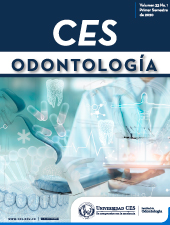Clinical consequences and behaviors in relation to accidents concerning extravasation of NaClO in endodontics
DOI:
https://doi.org/10.21615/cesodon.33.1.6Keywords:
endodontics, accident prevention, root canal irrigants, sodium hypochloriteAbstract
Endodontic therapy predicts the chemical-mechanical decontamination of the root canals sodium hypochlorite (NaClO) being the most commonly used chemical. A critical review of the literature on the consequences of accidentsby extravasation of NaClO during endodontic treatments and clinical necessary procedures in such cases. We searched the Scielo and Lilacs databases with descriptors in Portuguese and in the PubMed database with descriptors in English, being obtained 98 articles records available for complete reading, published between 2003-2018. Those whose subjects answered the questions in discussion were included: HClO as an endodontic irrigator; factors that affect the extrusion of hypochlorite in endodontic treatments, consequences and clinical management in case of extravasation of the irrigant. The extrusion of hypochlorite beyond the apical foramen leads to tissue destruction and necrosis. However, there are few studies with recommendations after accidents due to extravasation of NaClO in the endodontic clinic. In cases of accidents, the substance should be aspirated and the area washed with sterile saline. There is no single protocol for intervention, the extent and severity of the accident must be assessed. The priority is pain relief, edema control and prevention of secondary infections. The professional must take into account the daily possibility of accidents and take preventive measures.
Downloads
References
Medici MC, Fröner IC. A scanning electron microscopic evaluation of different root canal irrigation regimens. Braz Oral Res 2006;20(3):235-240.
Tomazinho LF, Silva DCC, Fagundes FS, Tomazinho PH. Estudo in vitro da atividade antimicrobiana de soluções irrigadoras na eliminação de Enterococcus faecalis. Revista Sul-brasileira de odontologia 2007;4(1):12-16.
Cecchin D, Farina AP, Barbizam JVBb Paranhos MPG, Júnior BC. Effect of endodontic irrigating solutions on the adhesive bond strength to dentin. Rev Odonto Cienc 2011;26(4):341-345.
Soares RG, Dagnese C, Irala LED, Salles AA, Limongi O. Injeção acidental de hipoclorito de sódio na região periapical durante tratamento endodôntico: Relato de caso. Revista Sul-brasileira de odontologia 2007;4(1):17-21.
Camoes ICG, Salles MR, Fernando MVM, Freitas LF, Gomes CC. Relationship between the size of patency file and apical extrusion of sodium hypochlorite. Indian Journal of Dental Research 2009;20 (4):426-430.
Pitome AW, Cruz ATG, Heck AR, Faria MIA, Aragão EM. Avaliação da capacidade de dissolução de tecido pulpar bovino pelo hipoclorito de sódio em diferentes concentrações. Rev Odontol UNESP 2015;44(6): 351-354.
Mendonça ESBV, Pereira KFS. Influência da solução irrigadora na formação de defeitos dentinários após preparo com Sistema Reciproc. Rev Odontol UNESP 2017;46(2):90-96.
Coutinho-Filho TS, Ferreira CMA, Silva EJNL, Souza-Filho FJ. Behavior of subcutaneous tissue of rats in response to infected dentine associated with different endodontic irrigants. Rev Odonto Cienc 2012;27(3):223-227.
Salum G, Barros Filho S, Rangel LFGO, Rosa RH, Santos SSF, Leão MVP. Hipersensibilidade ao hipoclorito de sódio em intervenções endodônticas. Rev. odontol. Univ. Cid. São Paulo (Online). 2012; 24(3): 200-208.
Kıvanç BH, Arısu HD, Yanar NÖ, Silah HM, İnam R, Görgül G. Apical extrusion of sodium hypochlorite activated with two laser systems and ultrasonics: a spectrophotometric analysis. BMC Oral Health. 2015; 15:71.
Fidalgo TKS, Barcelos R, Petrópolis DB, Azevedo BR, Primo LG, Silva-Filho FC. Citotoxidade de diferentes concentrações de hipoclorito de sódio sobre osteoblastos humanos. RGO 2009;57(3):317-321.
Zhu WC, Gyamfi J, Niu LN, Schoeffel GJ, Liu SY, Santarcangelo F, Khan S, Tay KC, Pashley DH, Tay FR. Anatomy of Sodium Hypochlorite Accidents Involving Facial Ecchymosis – A Review. J Dent. 2013;41(11):935-948.
Guivarc’h M, Ordioni U, Ahmed HMA, Cohen S, CatherineJH, Bukiet F. Sodium Hypochlorite Accident: A Systematic Review. JOE 2017;43(1):16-24.
Huang Q, Barnes JB, Schoeffel GJ, Fa, B, Tay C, Bergeron BE. et al. Effect of Canal Anastomosis on Periapical Fluid Pressure Build-up during Needle Irrigation in Single Roots with Double Canals using a Polycarbonate Model. Scientific Reports, 2017; 7:1582. http://doi.org/10.1038/s41598-017-01697-1
Chaugule VB, Panse AM e Gawal PN. Adverse Reaction of Sodium Hypochlorite during Endodontic Treatment of Primary Teeth. International Journal of Clinical Pediatric Dentistry 2015;8(2):153-156.
Can EDB, Kazanda MK, Kaptan RF. Inadvertent Apical Extrusion of Sodium Hypochlorite with Evaluation by Dental Volumetric Tomography. Case Reports in Dentistry. 2015; doi: 10.1155 / 2015/24754
Bosch-Aranda ML, Canalda-Sahli C, Figueiredo R, Gay-Escoda C. Complications following an accidental sodium hypochlorite extrusion: a report of two cases. J. Clin Exp Dent 2012; (3):194-198.
Melo TAF, Oliveira EPM. Sinusite maxilar por injeção acidental de hipoclorito de sódio. Stomatos 2005;11(21): 27-32.
Câmara AC, Albuquerque MM, Aguiar CM. Soluções Irrigadoras Utilizadas para o Preparo Biomecânico de Canais Radiculares. Pesq Bras Odontoped Clin Integr. 10(1):127-133, 2010.
Downloads
Published
How to Cite
Issue
Section
License
Copyright (c) 2020 CES Odontología

This work is licensed under a Creative Commons Attribution-NonCommercial-ShareAlike 4.0 International License.
| Article metrics | |
|---|---|
| Abstract views | |
| Galley vies | |
| PDF Views | |
| HTML views | |
| Other views | |



